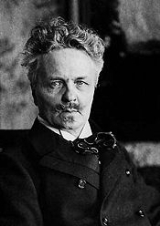
playwright, novelist, poet, essayist and painter. A prolific writer who often drew directly on his personal experience, Strindberg's career spanned four decades, during which time he wrote over 60 plays and more than 30 works of fiction, autobiography, history, cultural analysis, and politics. A bold experimenter
and iconoclast throughout, he explored a wide range of drama
tic methods and purposes, from naturalistic
tragedy
, monodrama
, and history plays, to his anticipations of expressionist and surrealist
dramatic techniques.
People who keep dogs are cowards who haven't got the guts to bite people themselves.
![]()
In that first prolific period of painting,my painting had a theraputic function.(Strindberg was also a talented amateur painter)
![]()
When is revolution legal? When it succeeds!
![]()
I loathe people who keep dogs. They are cowards who haven't got the guts to bite people.
![]()
What is economics? A science invented by the upper class in order to acquire the fruits of the labor of the underclass.
![]()
When they say Christ descended into Hell, they mean that he descended to earth, this penitentiary, this madhouse and morgue of a world.
![]()
Woman, being small and foolish and therefore evil, should be suppressed like barbarians and thieves. She is useful only as an ovary and womb, best of all as a cunt.
![]()
By aiming for the impossible, you reach the highest level of the possible. (Or: To reach for the outmost possibility, you've got to aim for the impossible)
![]()
See you in my next book, you bastard! (From a letter to a journalist who had criticized his work)
![]()

